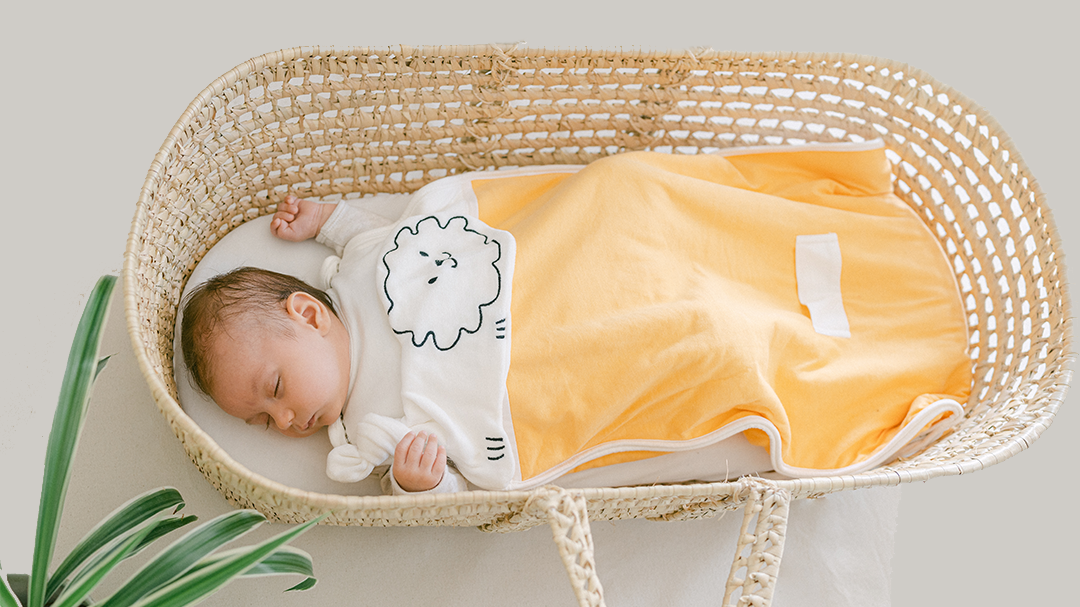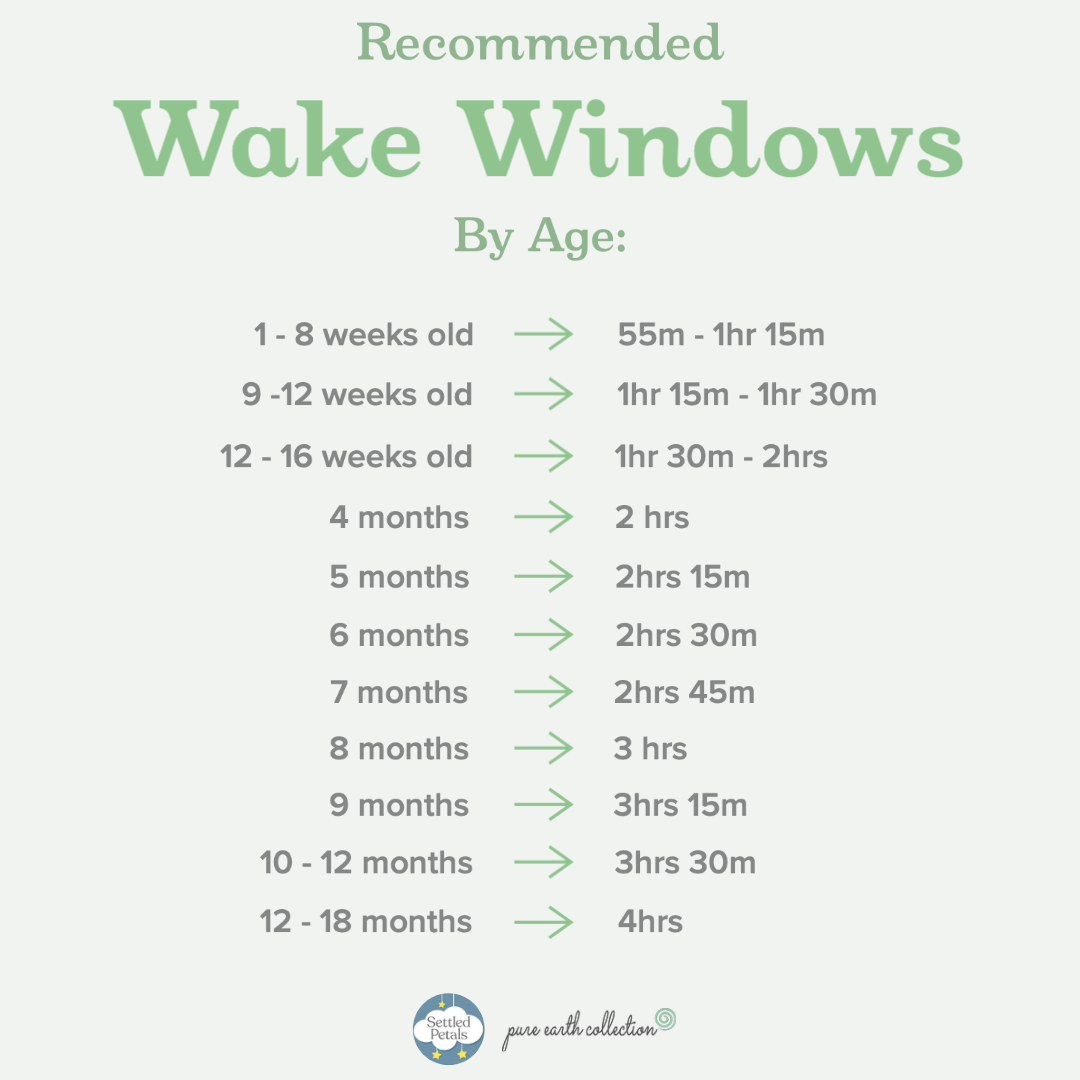Guest blog written by Susan Wallace, founder of Settled Petals, an expert in infant sleep, potty training, baby yoga & baby massage.

When a baby becomes overtired they may become irritable, find it difficult to fall asleep, wake more often and experience early rising. There are several ways to prevent your baby from becoming overtired, and each family may have a different preference for what works for them. Here are some options:-
Option 1: Follow Baby Wake Windows by Age
Some families find it useful to follow baby wake windows during the day. A baby’s wake window is the time period from one sleep time to another. These can be useful for babies under 5 – 6 months of age. It allows parents a timeframe to help them to predict when their baby may be tired, in the hope of avoiding overtiredness. It is worth noting that wake windows are not evidence-based – there is no research to suggest the ‘correct’ wake window for a particular age group. Babies of the same age may have different sleep requirements than other babies the same age, which can cause some parents to feel frustrated if they follow a set wake window guide, only to find their individual baby is over or under tired using the suggested times.
Some parents ask for a specific guide, as a base. Newborn wake windows will be very short and will increase gradually as they get older. From my experience (not research) this is a rough guide which can be useful. But it should be adapted in line with the individual sleep cues of a particular child. It donates the maximum wake windows per age:
- 1 – 8 weeks old: 55 minutes – 1 hour 15 minutes
- 9 – 12 weeks: 1 hour 15 minutes – 1 hour 30 minutes
- 12 – 16 weeks old: 1 hour 30 minutes – 2 hours
- 4 months: 2 hours
- 5 months: 2 hours 15 minutes
Usually, most children respond best if the first wake window of the day (morning wake to nap 1) is slightly less than the other wake windows. For example, a 4-month-old who responds well to a 2-hour wake window during the day may prefer just 1 hour 30 minutes wake time in the morning. For those babies who avail of a final catnap before bed, it is usually advantageous to offer a slightly shorter wake window between this and night sleep.
From around 5 – 6 months many families find that a set schedule works better than wake windows.

Option 2: Follow a Baby Sleep Routine / Schedule
Before the age of 5 – 6 months, most babies do not respond well to a set schedule. This is because their circadian rhythm (24-hour body clock) is only developing, making predictability difficult.
Some parents choose to implement a gentle sleep routine for babies from around 5.5 months. This can promote more predictable sleep. Most babies drop to 3 naps around 5 – 6 months. Many drop to 2 naps between 7 – 9 months, and to 1 napping between 14 – 18 months (a small amount may drop at 12 months). Again, this is just based on experience, not research-based evidence, so please do not worry if your baby follows a different pattern. There is no ‘right’ schedule, but rather a tool to prevent overtiredness, should it appeal to a particular parenting style.
Again many babies respond best when the wake period between morning wake and nap 1 is slightly shorter than the other periods. On a 3-nap baby sleep schedule it often works best if the final nap is a catnap, and therefore the period between nap 3 and bedtime is shorter than other wake windows. Once availing of a 1 and 2 nap schedule, usually the period before bed is the longest wake window.
Although individual sleep cues should be followed to ensure the schedule works for a particular child, based on my experience these are usually the maximum wake windows per age:
- 4 months – 2 hours
- 5 months – 2 hours 15 minutes
- 6 months – 2 hours 30 minutes
- 7 months – 2 hours 45 minutes
- 8 months – 3 hours
- 9 months – 3 hours 15 minutes
- 10-12 months – 3 hours 30 minutes
- 12-18 months – 4 hours
Option 3: Follow Baby’s Sleep Cues
Some families prefer to look out for typical sleep cues for babies and offer a nap when these are observed.
Newborn sleep cues (under 16 weeks) may include:
- Rubbing their eyes
- Diverting their eyes / looking away
- Staring / Saucer-eyes
- Pulling at their ears
- Sucking (breast or bottle) with less force
- Behaviour becomes fussy or irritable
- Hiccups
- Yawning
The advantage of this approach is that it is baby-led and individual to the specific child. However, some babies only offer subtle clues that they are becoming tired, so often parents do not realise their little one is tired until they are already overtired. Crying is often a sign baby is overtired, rather than at optimum period for a nap. They can then become more difficult to settle.
Option 4: Go With The Flow
Baby wake windows and set sleep schedules are simply tools to help some families prevent overtiredness. They are just meant as a guide, and some families choose not to use them, instead just going with the flow and letting baby sleep as and when they happen to. This approach may be particularly advantageous for parents who find baby sleep routines restrictive or stressful, or who have busy schedules which does not allow much time in the house. If you fall into this category and it works for you and your baby, please be assured that this is of course absolutely fine. Schedules and wake windows are only a tool for those who find them useful, and families successfully raised children for many, many years before they gained popularity. The ’best’ approach is the one which works for an individual child and their family.
And one of my top tips for helping babies with their daytime sleep is investing in a good quality baby blackout blind. I love the Pure Earth Collection organic blackout blinds as they don’t use any PVC or toxic plastics (which are bad for indoor air quality), so they help keep the air in the baby’s nursery nice and clean! Plus they’re really sticky and easy to put up.
I love to work with families on an individual basis to respect parenting styles. For more sleep tips or support with potty training or baby massage, please reach out via my website: www.settledpetals.com
